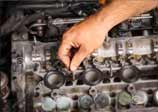
Typical fuel pump installed on many inboard equipped catalinas. Notice there is only a positive wire.
Learning the hard way
There is nothing worse than motoring up an unfamiliar lee shore and having the engine stop. Years ago, on a charter boat in the Grenadines, I had just such an adventure aboard a 50 footer.
We had a great sail. 30 knot trade winds. We were rockin' and rollin'. Large quartering seas. Large enough the wheel lifted the young woman at the helm right off the cockpit sole when one wave rolled under the stern! After one of the larger crew members dove aft, grabbed the wheel and brought her back down to earth, we decided it was time to head for an anchorage. The required beat to weather would have taken until long after sunset (when we should have already been at anchor).
So we fired up the diesel for a motor to weather. As we approached our anchorage and had need to navigate through coral and avoid a lee shore, the engine suddenly quit. Luckily, I had an experienced crew aboard.
In spite of the rum punch served all round during the motor to weather, and immediately recognizing the danger, the crew jumped to the halyards and hoisted sail. By backing the genoa, we were able to spin the boat around almost within it's own length. Now under sail alone, we headed back out the channel the way we had entered with coral heads to port and starboard. The crew then stood off, reaching back and forth offshore of the harbor in unabated winds.
Meanwhile, two of us headed below and dove into the engine compartment. With the combination of motion, attitude and diesel fumes we were both about to have a long conversation with Ralph and Earl on the Big White Telephone. In order to maintain, we worked in shifts troubleshooting the engine.








